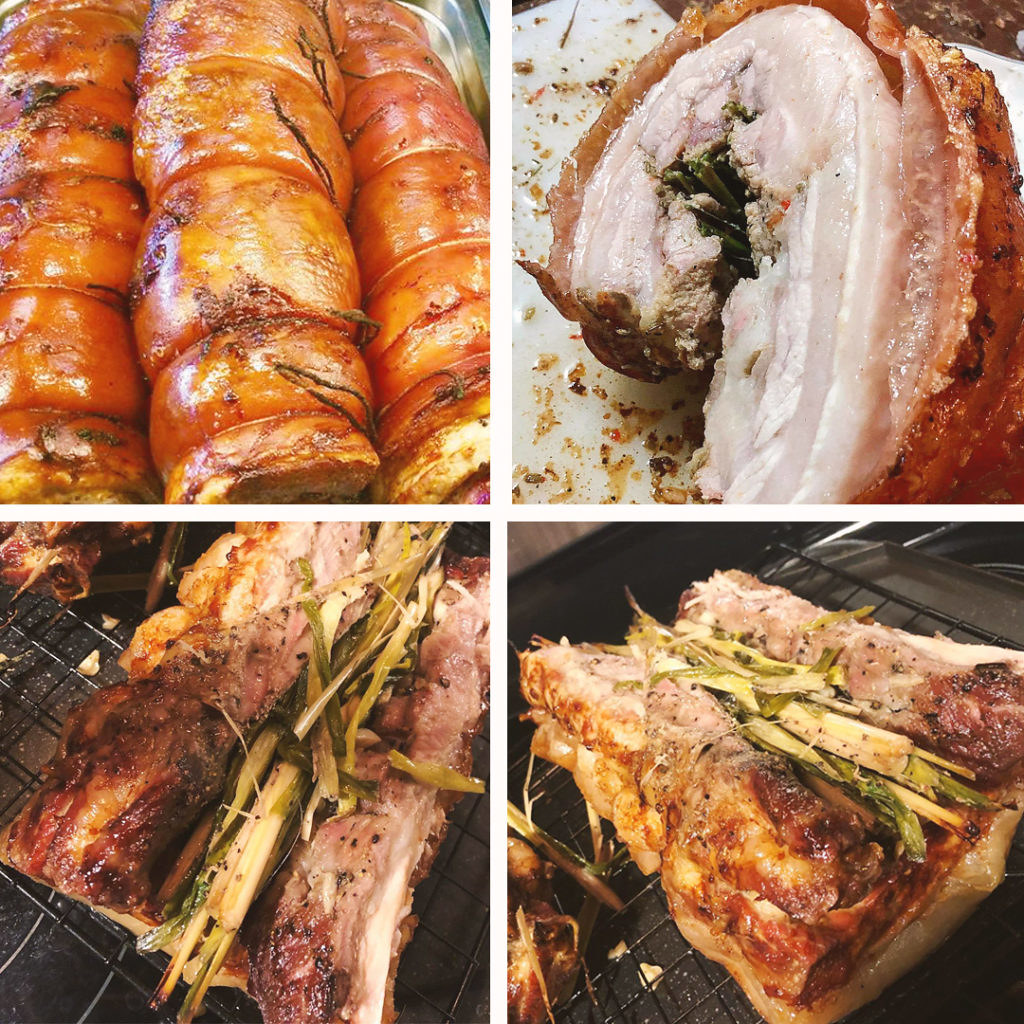
Lechon is an integral part of Filipino cuisine, symbolizing celebration, indulgence, and culinary mastery. While traditional lechon involves roasting a whole pig, lechon belly offers a more convenient and accessible alternative—delivering the same mouthwatering, crispy skin and juicy meat in a smaller, more manageable portion.
In this guide, we’ll walk you through everything you need to know about lechon belly, from its origins and cultural significance to a step-by-step cooking process.
What is Lechon Belly?
Lechon belly, also called “boneless lechon”, is a rolled and roasted pork belly seasoned with a blend of spices and aromatics, including lemongrass, garlic, and vinegar. Unlike traditional whole lechon, which requires a large roasting pit, lechon belly can be cooked in a standard oven or over a charcoal spit, making it ideal for home cooks and small businesses.
The result? Crispy, golden-brown skin with flavorful and tender meat that melts in your mouth.
Why is Lechon Belly So Popular?
Lechon belly has surged in popularity for several reasons:
✔ Convenience – No need for a whole pig; just a section of the belly is enough to serve a crowd.
✔ Affordability – More budget-friendly than ordering an entire lechon.
✔ Flavorful & Crispy – The skin achieves the signature crispiness, while the meat remains juicy.
✔ Perfect for Business – Many food entrepreneurs have started small-scale lechon belly businesses, selling per kilo or as party platters.
If you’re considering turning lechon belly into a profitable business, check out this Best Lechon Guide in the Philippines to learn about market demand, pricing, and tips for success.
How to Cook the Best Lechon Belly (Step-by-Step Recipe)
Making lechon belly at home requires patience and attention to detail. Here’s a tried-and-tested crispy lechon belly recipe to help you achieve that perfect crunch and juiciness.
🔹 Ingredients:
✔ 1 whole pork belly (approx. 6-7 lbs), ribs removed
✔ 2 tbsp coarse salt
✔ ½ tsp freshly ground black pepper
✔ ½ cup white vinegar
✔ 3 stalks lemongrass, pounded to release aroma
✔ 4 shallots, thinly sliced
✔ 1 head garlic, crushed
✔ 3 tbsp soy sauce
✔ 1 tbsp sugar
✔ 1 tbsp annatto oil (for added color and crispiness)
🔹 Preparation Steps:
1. Prepare the Pork Belly
- Lay the pork belly flat on a clean surface, skin side down.
- Rub salt, black pepper, and vinegar evenly over the meat.
- Arrange lemongrass, shallots, and garlic on top of the meat.
2. Roll and Secure the Belly
- Carefully roll the pork belly into a tight log, ensuring the skin is on the outside.
- Tie it securely with kitchen twine to maintain its shape during roasting.
3. Dry the Skin for Maximum Crispiness
- Place the rolled pork belly on a wire rack over a tray and refrigerate uncovered for at least 8 hours or overnight.
- This drying process is crucial for getting crispy skin later.
4. Roasting the Lechon Belly
Oven Method:
- Preheat the oven to 180°C (350°F).
- Position the pork belly roll on a roasting rack inside a roasting pan.
- Roast for 2 hours, rotating occasionally for even cooking.
- After 2 hours, increase the temperature to 220°C (430°F) and roast for another 30 minutes, or until the skin turns crispy and golden brown.
Charcoal Spit Method (Traditional)
- Roast over indirect heat on a rotisserie spit for 3-4 hours, basting occasionally with annatto oil.
- Keep rotating to achieve even crisping.
5. Rest and Serve
- Once done, remove the lechon belly from the oven.
- Let it rest for 10-15 minutes before slicing to allow the juices to settle.
- Serve with spiced vinegar or liver sauce.
Expert Tips for the Crispiest Lechon Belly
✔ Drying the skin properly – Refrigerate overnight to reduce moisture.
✔ Using high heat at the end – Helps blister the skin for extra crispiness.
✔ Scoring the skin lightly – Encourages even cooking and crispy texture.
✔ Avoiding excessive moisture – Do not baste with too much liquid to prevent sogginess.
Lechon Belly Business: Is It Profitable?
Given Filipinos’ love for lechon, selling lechon belly is a highly profitable business idea. Many food entrepreneurs earn by offering:
✅ Lechon belly per kilo – Perfect for small family gatherings.
✅ Lechon belly trays – Great for events, birthdays, and holidays.
✅ Frozen lechon belly – Ready-to-cook versions for convenience.
A small business can start with minimal investment, and with proper marketing (social media promotions, delivery services, and catering partnerships), you can easily scale up your operations.
Want to learn more about the lechon business? Read this Ultimate Lechon Guide in the Philippines for detailed insights!
Frequently Asked Questions (FAQs)
1. What is the difference between lechon belly and whole lechon?
Lechon belly is a boneless, rolled pork belly, while whole lechon is an entire roasted pig. The belly version is easier to cook and serve, making it ideal for small gatherings.
2. How do I keep lechon belly crispy for hours?
After cooking, let it rest in an open, dry area (do not cover immediately). If needed, reheat in an oven at 200°C (400°F) for 10 minutes to revive crispiness.
3. Can I cook lechon belly in an air fryer?
Yes! For smaller portions, air frying at 200°C (400°F) for 45 minutes to 1 hour works well. Rotate periodically for even crisping.
4. What’s the best sauce for lechon belly?
Spiced vinegar (for a tangy, acidic contrast)
Liver sauce (rich and savory)
Soy-calamansi dip (for a balanced umami flavor)
Final Thoughts
Lechon belly is the perfect way to enjoy the flavors of traditional lechon without the need for a whole pig. Whether you’re making it for a special occasion or considering it as a business opportunity, mastering the perfect crispy, juicy lechon belly can be a game-changer.
Want more lechon-related tips? Check out this in-depth Lechon Guide in the Philippines for everything you need to know about this beloved dish!

